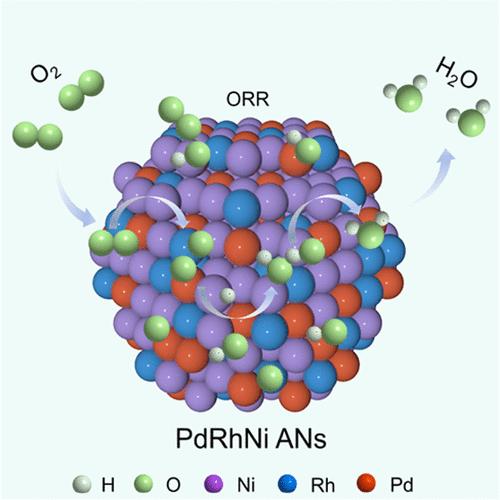当前位置:
X-MOL 学术
›
Inorg. Chem.
›
论文详情
Our official English website, www.x-mol.net, welcomes your
feedback! (Note: you will need to create a separate account there.)
Ligand Effect-Induced Electronic Structure Manipulation of Media-Entropy Alloy for Remarkable Stability over 50,000 Cycles in Oxygen Reduction
Inorganic Chemistry ( IF 4.3 ) Pub Date : 2024-11-19 , DOI: 10.1021/acs.inorgchem.4c04200 Sijie Chen, Dingwen Bao, Luping Zhang, Yue Xu, Yukun Peng, Jie Liu, Tongfei Li, Xi Zhou, Chenglin Yan, Tao Qian
Inorganic Chemistry ( IF 4.3 ) Pub Date : 2024-11-19 , DOI: 10.1021/acs.inorgchem.4c04200 Sijie Chen, Dingwen Bao, Luping Zhang, Yue Xu, Yukun Peng, Jie Liu, Tongfei Li, Xi Zhou, Chenglin Yan, Tao Qian

|
Modulating the “trade-off” between activity and durability of Pd-based alloys while eliminating the dissolution of the nonprecious metal element issue is highly significant for the advancement of commercializing anion-exchange membrane fuel cells (AEMFCs). Herein, by harmonizing composition and ligand effects and targeting the stability concerns of Pd-based alloys, we propose PdRhNi ternary medium-entropy-alloy (MEA) networks (PdRhNi ANs) as exceptionally efficient oxygen reduction reaction (ORR) electrocatalysts via ligand effect. The results of theoretical calculations provide compelling evidence that the ligand effect of Ni in PdRhNi ANs, which can endow an inductive effect to reshape the electronic configuration to induce a reduced energy barrier in the rate-determining steps, optimizes the adsorption energy of O-related intermediates and lowers the d-band center of metal species, collectively boosting the anti-CO capacity and the ORR efficiency. Consequently, the as-made PdRhNi ANs not only demonstrate significantly enhanced electrocatalytic properties with a half-wave potential of 0.85 V and excellent resistance to CO toxicity, in contrast to those of commercial Pt/C and binary counterparts, but also exhibit a negligible half-wave potential decline after 50,000 cycle stability examination. More excitingly, the homemade AEMFC with a PdRhNi AN air cathode delivers a higher power density of 109 mW cm–2, surpassing that of the PdRh AN-based battery, highlighting promising prospects for implementing MEA materials with ligand engineering in AEMFC environments.
中文翻译:

配体效应诱导的介质熵合金电子结构操纵,在氧还原中具有超过 50,000 次循环的显着稳定性
调节 Pd 基合金的活性和耐久性之间的“权衡”,同时消除非贵金属元素的溶解问题,对于阴离子交换膜燃料电池 (AEMFC) 的商业化发展具有重要意义。在此,通过协调成分和配体效应并针对 Pd 基合金的稳定性问题,我们提出了 PdRhNi 三元中等熵合金 (MEA) 网络 (PdRhNi ANs) 作为通过配体效应的异常高效的氧还原反应 (ORR) 电催化剂。理论计算结果提供了令人信服的证据,证明 PdRhNi ANs 中 Ni 的配体效应可以赋予感应效应来重塑电子构型,从而在速率确定步骤中诱导降低的能量势垒,优化了 O 相关中间体的吸附能并降低了金属种类的 d 波段中心,共同提高了抗 CO 能力和 ORR 效率。因此,与市售 Pt/C 和二元同类产品相比,成品 PdRhNi ANs 不仅表现出显著增强的电催化性能,具有 0.85 V 的半波电位和优异的抗 CO 毒性性能,而且在 50,000 次循环稳定性检查后,半波电位下降可以忽略不计。更令人兴奋的是,带有 PdRhNi AN 空气阴极的自制 AEMFC 可提供 109 mW cm–2 的更高功率密度,超过了基于 PdRh AN 的电池,突出了在 AEMFC 环境中使用配体工程实现 MEA 材料的前景。
更新日期:2024-11-20
中文翻译:

配体效应诱导的介质熵合金电子结构操纵,在氧还原中具有超过 50,000 次循环的显着稳定性
调节 Pd 基合金的活性和耐久性之间的“权衡”,同时消除非贵金属元素的溶解问题,对于阴离子交换膜燃料电池 (AEMFC) 的商业化发展具有重要意义。在此,通过协调成分和配体效应并针对 Pd 基合金的稳定性问题,我们提出了 PdRhNi 三元中等熵合金 (MEA) 网络 (PdRhNi ANs) 作为通过配体效应的异常高效的氧还原反应 (ORR) 电催化剂。理论计算结果提供了令人信服的证据,证明 PdRhNi ANs 中 Ni 的配体效应可以赋予感应效应来重塑电子构型,从而在速率确定步骤中诱导降低的能量势垒,优化了 O 相关中间体的吸附能并降低了金属种类的 d 波段中心,共同提高了抗 CO 能力和 ORR 效率。因此,与市售 Pt/C 和二元同类产品相比,成品 PdRhNi ANs 不仅表现出显著增强的电催化性能,具有 0.85 V 的半波电位和优异的抗 CO 毒性性能,而且在 50,000 次循环稳定性检查后,半波电位下降可以忽略不计。更令人兴奋的是,带有 PdRhNi AN 空气阴极的自制 AEMFC 可提供 109 mW cm–2 的更高功率密度,超过了基于 PdRh AN 的电池,突出了在 AEMFC 环境中使用配体工程实现 MEA 材料的前景。


















































 京公网安备 11010802027423号
京公网安备 11010802027423号